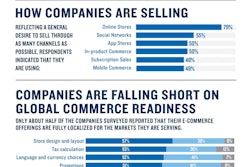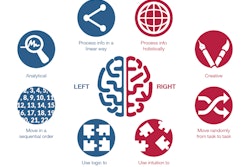
As executives and project managers research business-to-business (B2B) e-commerce solutions, it’s easy to get bogged down in feature lists, technologies and partner evaluations. It’s hard to visualize how the whole system will work. Unfortunately, the nature of B2B e-commerce encourages us to focus on the details of the solution before we outlined an organizational path for success.
Before you even begin researching solutions and contacting vendors, it’s crucial to look at the e-commerce venture from three different angles—which are all interrelated: goal, commitment and journey.
You can’t just take technology and throw it at your market. Without the perspective of goal, commitment and journey, your company’s e-commerce venture will fail.
Goal
To succeed in e-commerce, you need to set specific, attainable and measurable goals for your organization. But for many, e-commerce is a new world. What kinds of goals should we set? How do those goals intersect with the well-established goals of the organization?
You can start to answer these questions by determining:
- Whom your e-commerce customers will be.
- How you’ll measure success for them and for you after the e-commerce implementation.
It’s easy to set overly ambitious goals, especially when it comes to e-commerce adoption across your customer base. But think of it like this: You wouldn’t come back from a holiday break and try to run a marathon. You have to start right where you are. If you don’t run regularly, your first order of business is to go for a short jog. But after your first foray, you’re still not ready for the marathon. You’re just ready to run a little farther than you did yesterday.
B2B e-commerce is the same way. In reality, your new online sales portal doesn’t have to address all of your customers on Day 1 (more on that when we get to the journey). It’s best to plan your initial implementation to meet the needs of one specific set of customers. You can adapt the solution to reach a larger set of your customers after the success of your initial implementation.
Defining Your Goals: Why E-Commerce?
It’s also crucial to determine why you’re pursuing an e-commerce solution in 2017. There are many goals that could lead a company to an e-commerce solution:
- Getting more revenue from existing customers.
- Attracting new customers.
- Facilitating business with existing customers.
- Reducing the cost of helping low-value customers.
- Altering your distribution channel by going direct versus distributors and dealers?
If you’re just getting into e-commerce in 2017, you’re already a late adopter. You’re not on the bleeding edge. There are deeper strategic and organizational questions to consider, too:
- Why now?
- Are you threatened in the market?
- Are you trying to pre-empt a loss of market share?
- Do you have support of the whole organization?
It’s not just about putting the technology in place. Organizations that adopt an e-commerce solution for the sake of technology are putting the cart before the horse. Ultimately, they will find themselves less competitive than companies that adopted e-commerce in the service of a clearly defined goal.
Unifying Goals: Helping Stakeholders Work Together
There are many organizational stakeholders in the e-commerce journey: marketing, sales, sales operations, finance, product management, manufacturing, warehouse and distribution, etc. Unfortunately, everyone has different priorities. It’s critical to establish corporate consensus on the goals of your e-commerce project. Marketing may have a different view than sales, customer support or executives. You will encounter tensions that pull the project in different directions. The most powerful e-commerce technology will fail if the project leaders can’t set goals and communicate the value of those goals (as well as the participation required) across the organization.
Choosing Initial Goals that Are Attainable
If you just want to get your feet wet, there are plenty of software-as-a-service (SaaS)-based platforms that you can use to establish a simple e-commerce operation. It’s a small goal and easily attainable, and you can accomplish something. You can just throw up a business-to-consumer (B2C) site that doesn’t have to deal with contract pricing, special delivery or inventory levels in your enterprise resource planning (ERP) system. Setting up a small shop like this allows you to take orders and get used to the process.
But if your existing customers are tired of phone, fax and email ordering, you can’t fix that problem with a B2C-oriented SaaS solution. To do B2B e-commerce efficiently at scale, you have to share data in real time between your customer relationship management (CRM), accounting, ERP and e-commerce solution. You have to handle complex relationships between ship-tos, sold-tos and payers. You may need to offer different payment options, shipping from multiple plants and variable pricing models tied to user ID.
In the B2B world, much more than in B2C, you should not dismiss the importance of integration to back-office systems. Unless you want a separate, stand-alone e-commerce business—but nobody wants that. The goal is an e-commerce solution that is vertically integrated with the organization and helps the company better satisfy its customers.
Eventually, you should aspire to get 20 to 40 percent of your revenue coming from a web channel—but you should set incremental goals for growth. Perhaps you want to grow your web-channel revenue by 5 percent a quarter. You could make this goal measurable and attainable by going after customers in a specific geographical area. But you need to consider everything required to support these attainable growth goals. If you bring e-commerce to another geographical market, will your e-commerce solution require multiple language and currency support? For each 5 percent you want to grow, your e-commerce solution may need tweaks to support that growth.
Commitment
After you define the goal, it’s time to establish commitment. The commitment required to make e-commerce work will cover the entire organization, from the conversation with the customer all the way to shipment, payment and invoices.
There are many organizations and departments in the company that must commit to the project. It will impact each of them and their business processes. The e-commerce manager might say, “I want to take credit cards.” But finance says, “Sorry, we can’t really do that because we already gave customers the ability to pay on invoice. If they surpass their credit limit in that payment method, why give them more credit before they pay down their balance with us?” The commitment to e-commerce may require new strategies for collecting on credit balances.
Maybe the e-commerce manager builds a website to deliver products in small quantities, but the warehouse crew can’t deliver that because the product only comes in large cartons. One or both parties may need to adjust to maintain a cohesive commitment to e-commerce across the organization.
Journey
While the e-commerce project should have a definite implementation cycle and launch date, it’s important to remember that e-commerce will always be a work in progress. This is not so much due to flawed implementations as it is to changing customer needs and changing corporate goals.
Perfection: The Enemy of the Good
Seeking perfection in the initial e-commerce launch may very well hold a company back from starting with small successes. In reality, you don’t have to have the features in place for all customers when you launch the project. In fact, you should allow for changes in business priorities, market conditions, customers’ tech preferences and things that you learn along the way.
This isn’t a one-and-done project. This is the start of a new journey. You’ll have to continue to engage. New customers will come with new expectations. New devices will be launched that have to be supported. New, more efficient business processes will emerge and need support. Maybe today, you’re just selling SKUs from a catalog. Tomorrow, you want to give your customer’s warehouse staff a handheld device to scan barcodes on shelves and replenish inventory. But there’s no need to go there on Day 1.
Maybe you don’t accept credit cards on Day 1. But six months down the road, you bring in a new, high-value customer who wants that payment method. Or maybe you want to diversify your distribution and go B2C with the platform.
Starting Small and Trusting the Process
It’s all about the journey. The organization needs to start small and get some wings. As the journey evolves, you have to return to the goal stage continuously. What’s working? What isn’t working? Perhaps you achieved one goal and still need to work on another. Perhaps you pursued the wrong goal initially. Without goal review, the journey risks falling into stagnation.
Answering New Questions as You Grow
Whom are you going to partner with? You’ll learn fast that you don’t have skills in-house to solve all of this. You need people who understand integration to your ERP system, CRM and so on. How much talent do you have in-house? How much do you want to spend? You can forecast these things at the outset, but the journey will also surprise you, for good and for bad.
These questions are especially important if you’re extending B2B e-commerce capabilities to your existing customers, as opposed to building an e-commerce solution to attract new customers. The second option is much simpler. If your goal is to make business easier for existing customers, that’s a much harder job. All your data is in your ERP system; you have existing business processes for finance, shipment, product announcements and more. Now all these systems have to get reviewed and integrated with the e-commerce solution. People who don’t usually talk to each other within the organization have to collaborate.
You have to allow this change management to occur in your organization. You want to initiate bite-sized changes so people can say, “Wow, that worked!” That will ease anxieties over the e-commerce transition, and will shore up your social capital and goodwill within the organization.
As you embark on this journey, the process by which you manage this project needs to test the organizational commitment and the goals you set up. Not all the initial goals will survive and the commitment of various parties could waver over time. You have to monitor this constantly. That’s the reason for big vision and small releases. If you’re trying to get the organization into the new space, which is foreign, this is the best way to guarantee success.
Sam Bayer is the co-founder and CEO of Corevist. His goal is to transform SAP e-commerce with affordable solutions, lightning-fast implementation times and B2C-inspired user experience. Connect with him on LinkedIn and Twitter.













![Pros To Know 2026 [color]](https://img.sdcexec.com/mindful/acbm/workspaces/default/uploads/2025/08/prostoknow-2026-color.mduFvhpgMk.png?ar=16%3A9&auto=format%2Ccompress&bg=fff&fill-color=fff&fit=fill&h=135&q=70&w=240)


